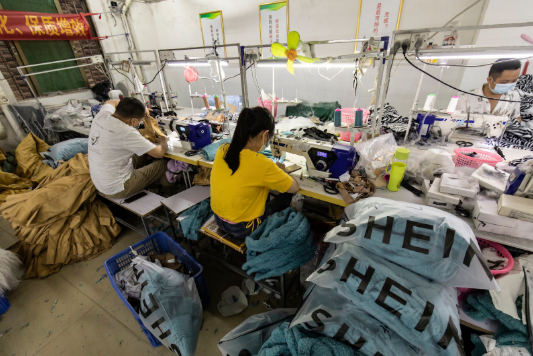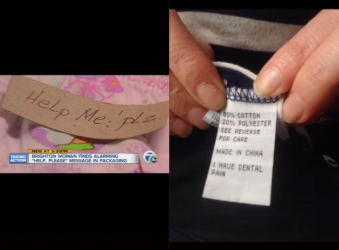
Introduction
As the seasons change, so does consumer interests, particularly in the consumption of fashion. It has been found in recent statistics that over 20% of clothing orders are placed online, significantly surging in Spring months like March and April. This seasonal increase has been closely linked to the phenomenon of “fast fashion,” a trend that has transformed the retail industry by making trendy clothing more accessible to audiences. However, this convenience comes at a significant cost, both ethically and environmentally. As consumers, it is essential to understand our shopping choices and the hidden consequences of the fast fashion industry.
The Rise of Fast Fashion

Fast fashion began to be publicized in the late ‘90s with brands like Zara and H&M becoming popular. However the concept began to be formed in the ‘70s with the growth of exports in American retail. Fast fashion is characterized by its stylish on brand timepieces, low prices, and high volume of production. Which often leads to a disposable culture where clothing is worn only a few times, before being discarded. According to 2020 data, fast fashion appeals primarily to younger consumers, particularly millennials and Gen Z, who are drawn to the constant influx of new styles and affordable fashion. However, the consequences of purchasing fast fashion are alarming. Fast fashion is often associated with abusive labor practices in developing countries, where low labor costs, limited education, and high poverty levels contribute to a workforce that includes children. This raises serious questions about child labor, abuse, and exploitation, as many young workers are forced into labor to support their families, often under hazardous and poor working conditions.
Additionally, the environmental impact of fast fashion is the biggest challenge.The industry is responsible for significant pollution, waste, and resource depletion, contributing to climate change and harming ecosystems worldwide. The production processes involved in fast fashion consume vast amounts of water and energy, causing great quantities of light pollution in the earth’s atmosphere, while the disposal of unused clothing leads to overflowing landfills and increased waste. Poor working conditions in factories further worsen the issue, as workers often face long hours, low wages, and unsafe environments to produce the fashion trends we know and love. The combination of these factors paints a troubling future for an industry that prioritizes profit over our workers and ecosystem.
Child labor scandal: Shein and Temu

Recent scandals involving brands like Shein and Temu have brought the dark side of fast fashion into the spotlight, igniting public outrage and calls for change. Allegations have surfaced regarding child labor, with disturbing notes found in clothing items stating, “Help me.” These revelations have sparked outrage and legal action, as consumers grapple with the reality of how their clothing is made. Shein has faced intense inspection for its labor practices, with influencers visiting their factories only to find that the misleading images of SHEINS working conditions showed no signs of abuse at all. After the group visited the factory, SHEIN received more backlash on social media for creating an idealized environment, covering up the abuse seen previously.

Many other reports suggest that many of these factories do not meet ethical standards, raising concerns about transparency in the supply chain and the true cost of cheap clothing.
Temu, on the other hand, is involved in a lawsuit by the European Union for allegedly selling illegal products online, breaching the Digital Services Act (DSA). This legal action highlights the ongoing challenges of regulating fast fashion and ensuring that companies adhere to ethical practices. The case against Temu underscores the need for stricter regulations in the fast fashion industry, as consumers increasingly demand transparency and accountability from the brands they support. As these scandals unfold, they serve as a reminder of the social dilemmas in fast fashion and the importance of advocating for fair labor practices and sustainable production methods.
Conclusion
As consumers, it is crucial to be mindful of where we shop and the implications of our purchasing decisions. The choices we make can have far-reaching consequences, not only for the workers who produce our clothing but also for the environment. When considering clothing, take a moment to evaluate prices and materials. Even items labeled as “non-toxic” or “natural” may still be part of the fast fashion cycle, often accompanied by greenwashing tactics that mislead consumers about the true sustainability of the products. To combat the negative effects of fast fashion, consider shopping second-hand or buying fewer items that you know you will wear multiple times. This approach not only helps reduce environmental risks but also promotes a more sustainable and ethical fashion industry. By making informed choices, we can contribute to a more responsible and compassionate world of fashion, encouraging brands to adopt better practices and prioritize the well-being of both people and the planet. Ultimately, our collective actions can drive meaningful change in the industry, fostering a future where fashion is not only stylish but also ethical and sustainable.
Works Cited:
CNN business. CNN. https://www.cnn.com/2024/08/23/business/china-shein-child-labor-audit-hnk-intl/index.html
Staff, N. (2023, June 26). Shein allegedly organised a fake press trip to its factories. nss magazine. https://www.nssmag.com/en/fashion/33570/shein-influencer-fake-trip
Guardian News and Media. (2024, October 31). EU launches action against shopping website Temu over illegal products. The Guardian. https://www.theguardian.com/world/2024/oct/31/eu-launches-action-against-shopping-website-temu-over-products
How do I know if a company is fast fashion? – Ashleigh Becker. Ashleigh Becker – Sela Designs. Ethical Fashion. Intentional Living. (2024, June 13). https://ashleighbecker.com/how-do-i-know-if-a-company-is-fast-fashion/#:~:text=Most%20fast%20fashion%20companies%20produce,email%20and%20ask%20 tough%20 questions
How can we reduce our fashion environmental impact? SustainYourStyle. (n.d.). https://www.sustainyourstyle.org/en/reducing-our-impact